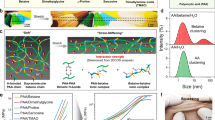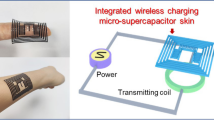Abstract
The advancement of technology has had a profound impact on all areas of life, with an ever more intimate integration of the digital and biological spheres, but it may also be accompanied by an environmental crisis caused by the abuse of large quantities of electronics and petrochemicals. Next-generation “green” electronics or iontronics with high biocompatibility, biodegradation, low cost and mechanical compliance promise to mitigate these adverse effects, but are often limited by the finite choices of materials and strategies. Herein, maltose syrup, a traditional water-dissolvable saccharide food called “JiaoJiao” in Chinese, is engineered to replace unsustainable conductive components of current electronic devices. After churning and pulling with two chopsticks, known as aeration, the aerated maltose syrup has optimized viscoelasticity, mechanical adaptation, robustness, remodeling and self-healing capability, yet with transient behavior. Moreover, the structural and viscoelastic evolution during aeration is also analyzed to maximize the contribution from structures. As a proof-of-concept, a type of “green” skinlike iontronics is prepared, which exhibits reliable strain sensing ability and is subsequently applied for intelligent information encryption and transmission based on a novel concept of sending Morse code. This work greatly extends the current material choice and is expected to shed light on the development of a sustainable future.

摘要
科技的发展对生活的各个领域都产生了深远的影响, 使得数字化领域和生物领域的结合越来越紧密, 但同时也可能伴随着电子设备和石化产品的滥用所带来的环境危机. 具有高生物相容性、生物降解性、低成本和顺应性的下一代“绿色”电子有望缓解这些不利影响, 但往往受限于材料和策略的选择. 本工作利用传统甜食“搅搅糖”(麦芽糖浆), 使用筷子对其进行结构改造, 即所谓的充气, 充气后的麦芽糖浆具有独特的黏弹性、力学适应性、可重构性和自修复能力, 但又兼具瞬态行为, 可以替代当前电子器件中不可回收的导电元件. 此外, 本文还分析了充气过程中结构和黏弹性的演变. 作为概念验证, 本文中制备的电容式离子皮肤具有可靠的应变传感能力, 可应用于新型的信息加密和传输. 这项工作将传统食物与前沿的科学研究相结合, 极大地拓展了材料的选择性, 有望为未来材料的可持续发展提供新的思路.
Similar content being viewed by others
References
Huang S, Liu Y, Zhao Y, et al. Flexible electronics: Stretchable electrodes and their future. Adv Funct Mater, 2019, 29: 1805924
Yuk H, Lu B, Zhao X. Hydrogel bioelectronics. Chem Soc Rev, 2019, 48: 1642–1667
Jian M, Wang C, Wang Q, et al. Advanced carbon materials for flexible and wearable sensors. Sci China Mater, 2017, 60: 1026–1062
Forrest SR. The path to ubiquitous and low-cost organic electronic appliances on plastic. Nature, 2004, 428: 911–918
Fu KK, Wang Z, Dai J, et al. Transient electronics: Materials and devices. Chem Mater, 2016, 28: 3527–3539
Irimia-Vladu M. “Green” electronics: Biodegradable and biocompatible materials and devices for sustainable future. Chem Soc Rev, 2014, 43: 588–610
Wang L, Chen D, Jiang K, et al. New insights and perspectives into biological materials for flexible electronics. Chem Soc Rev, 2017, 46: 6764–6815
Wang L, Wang K, Lou Z, et al. Plant-based modular building blocks for “green” electronic skins. Adv Funct Mater, 2018, 28: 1804510
Marr PC, Marr AC. Ionic liquid gel materials: Applications in green and sustainable chemistry. Green Chem, 2016, 18: 105–128
Li W, Liu Q, Zhang Y, et al. Biodegradable materials and green processing for green electronics. Adv Mater, 2020, 32: 2001591
Teng L, Ye S, Handschuh-Wang S, et al. Liquid metal-based transient circuits for flexible and recyclable electronics. Adv Funct Mater, 2019, 29: 1808739
Son D, Lee J, Lee DJ, et al. Bioresorbable electronic stent integrated with therapeutic nanoparticles for endovascular diseases. ACS Nano, 2015, 9: 5937–5946
Yin R, Yang S, Li Q, et al. Flexible conductive Ag nanowire/cellulose nanofibril hybrid nanopaper for strain and temperature sensing applications. Sci Bull, 2020, 65: 899–908
Wang C, Hou X, Cui M, et al. An ultra-sensitive and wide measuring range pressure sensor with paper-based CNT film/inter-digitated structure. Sci China Mater, 2020, 63: 403–412
Zhu B, Wang H, Leow WR, et al. Silk fibroin for flexible electronic devices. Adv Mater, 2016, 28: 4250–4265
Wang Q, Ling S, Liang X, et al. Self-healable multifunctional electronic tattoos based on silk and graphene. Adv Funct Mater, 2019, 29: 1808695
Wang C, Xia K, Zhang Y, et al. Silk-based advanced materials for soft electronics. Acc Chem Res, 2019, 52: 2916–2927
Baumgartner M, Hartmann F, Drack M, et al. Resilient yet entirely degradable gelatin-based biogels for soft robots and electronics. Nat Mater, 2020, 19: 1102–1109
Xu W, Yang H, Zeng W, et al. Food-based edible and nutritive electronics. Adv Mater Technol, 2017, 2: 1700181
Chang Q, He Y, Liu Y, et al. Protein gel phase transition: Toward superiorly transparent and hysteresis-free wearable electronics. Adv Funct Mater, 2020, 30: 1910080
Darabi MA, Khosrozadeh A, Wang Q, et al. Gum sensor: A stretchable, wearable, and foldable sensor based on carbon nano-tube/chewing gum membrane. ACS Appl Mater Interfaces, 2015, 7: 26195–26205
Lei Z, Huang J, Wu P. Traditional dough in the era of internet of things: Edible, renewable, and reconfigurable skin-like iontronics. Adv Funct Mater, 2020, 30: 1908018
Cao Y, Mezzenga R. Design principles of food gels. Nat Food, 2020, 1: 106–118
Wang X, Xu W, Chatterjee P, et al. Food-materials-based edible supercapacitors. Adv Mater Technol, 2016, 1: 1600059
Powrie WD. Chemical effects during storage of frozen foods. J Chem Educ, 1984, 61: 340
Lin Q, Xiao H, Liu GQ, et al. Production of maltose syrup by enzymatic conversion of rice starch. Food Bioprocess Technol, 2013, 6: 242–248
Saha BC, Zeikus JG. Improved method for preparing high maltose conversion syrups. Biotechnol Bioeng, 1989, 34: 299–303
Zúñiga R, Aguilera J. Aerated food gels: Fabrication and potential applications. Trends Food Sci Tech, 2008, 19: 176–187
Campbell G. Creation and characterisation of aerated food products. Trends Food Sci Tech, 1999, 10: 283–296
Campbell GM. Chapter 1-A history of aerated foods. In: Campbell GM, Scanlon MG, Pyle DL (eds.). Bubbles in Food 2. St. Paul: Woodhead Publishing and AACC International Press, 2008. 1–21
Weissenberg K. A continuum theory of rhelogical phenomena. Nature, 1947, 159: 310–311
Boland CS, Khan U, Ryan G, et al. Sensitive electromechanical sensors using viscoelastic graphene-polymer nanocomposites. Science, 2016, 354: 1257–1260
Suh D, Faseela KP, Kim W, et al. Electron tunneling of hierarchically structured silver nanosatellite particles for highly conductive healable nanocomposites. Nat Commun, 2020, 11: 2252
Hartel RW, von Elbe JH, Hofberger R. Aerated confections. In: Hartel RW, von Elbe JH, Hofberger R (eds.). Confectionery Science and Technology. Cham: Springer, 2018. 301–327
Wang J, Kliks MM, Jun S, et al. Rapid analysis of glucose, fructose, sucrose, and maltose in honeys from different geographic regions using Fourier transform infrared spectroscopy and multivariate analysis. J Food Sci, 2010, 75: C208–C214
Liu X, Liu J, Lin S, et al. Hydrogel machines. Mater Today, 2020, 36: 102–124
Fu X, Li J, Tang C, et al. Hydrogel cryo-microtomy continuously making soft electronic devices. Adv Funct Mater, 2020, 31: 2008355
Chun H, Chung TD. Iontronics. Annu Rev Anal Chem, 2015, 8: 441–462
Yang C, Suo Z. Hydrogel ionotronics. Nat Rev Mater, 2018, 3: 125–142
Chortos A, Bao Z. Skin-inspired electronic devices. Mater Today, 2014, 17: 321–331
Bai Y, Chen B, Xiang F, et al. Transparent hydrogel with enhanced water retention capacity by introducing highly hydratable salt. Appl Phys Lett, 2014, 105: 151903
Bai J, Wang R, Ju M, et al. Facile preparation and high performance of wearable strain sensors based on ionically cross-linked composite hydrogels. Sci China Mater, 2021, 64: 942–952
Someya T, Bao Z, Malliaras GG. The rise of plastic bioelectronics. Nature, 2016, 540: 379–385
Chandrasekhar A, Vivekananthan V, Khandelwal G, et al. A fully packed water-proof, humidity resistant triboelectric nanogenerator for transmitting Morse code. Nano Energy, 2019, 60: 850–856
Liu S, Cheng Y, Li Y, et al. Manipulating solid-state intramolecular motion toward controlled fluorescence patterns. ACS Nano, 2020, 14: 2090–2098
Qin R, Liu Y, Tao F, et al. Protein-bound freestanding 2D metal film for stealth information transmission. Adv Mater, 2018, 1803377
Acknowledgements
This work was supported by the National Natural Science Foundation of China (51733003).
Author information
Authors and Affiliations
Contributions
Huang J and Wu P designed the experiments. Huang J performed the experiments. Huang J and Wu P analyzed the data and wrote the paper.
Corresponding author
Additional information
Jiahui Huang received her BSc degree in textile chemistry and dyeing and finishing engineering at Donghua University in 2018 and currently is a PhD candidate at Fudan University. Her research mainly focuses on flexible hydrogel electronics and 3D printing multifunctional materials.
Peiyi Wu is a professor at the College of Chemistry, Chemical Engineering and Biotechnology, Donghua University (China) and a fellow of the Royal Society of Chemistry. He received his PhD degree from the University of Essen (Germany) in 1998. His research interests are focused on the 2D-IR spectroscopy, flexible hydrogel electronics and iontronics, and the synthesis and application of 2D materials.
Conflict of interest
The authors declare that they have no conflict of interest.
Supplementary Information
Supplementary material, approximately 6.94 MB.
Supplementary material, approximately 4.43 MB.
Supplementary material, approximately 5.08 MB.
Supplementary material, approximately 5.39 MB.
Rights and permissions
About this article
Cite this article
Huang, J., Wu, P. Engineering “JiaoJiao” (maltose syrup) with chopsticks: From traditional Chinese sweet food to skin-like iontronics. Sci. China Mater. 64, 3059–3068 (2021). https://doi.org/10.1007/s40843-021-1701-7
Received:
Accepted:
Published:
Issue Date:
DOI: https://doi.org/10.1007/s40843-021-1701-7




